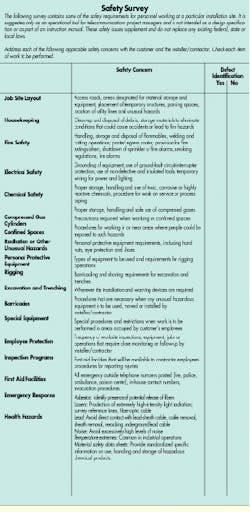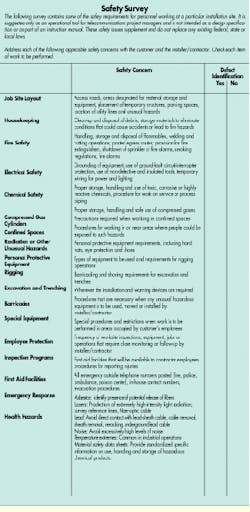Tony Minichiello
Maximis Communications Consultants Inc.
If you are a telecommunications consultant, customers will frequently require your services as a project manager. As such, you are responsible for overseeing many facets of the telecommunications installation project, including workplace health and safety hazards.
The installer/contractor is notified that the project manager is designated as the owner`s agent, but the installer/contractor is responsible for ensuring work safety and protection of workers during installation and upon its completion.
The contractor`s basic responsibility is for the field technicians. However, as project manager, you may find it necessary to determine that the contractor`s work practices are in conformance with the customer`s employee and health safety requirements for controlling hazards that can potentially cause injury or property damage.
Many telecommunications projects other than office buildings--for example, industrial, chemical, manufacturing, nuclear, oil refineries and military complexes--can have a predisposition for nonconformance to minimum safety conditions. Such projects can involve conditions that require stricter-than-normal standards for service contracts--for example, those conditions categorized as personal, equipment and job site.
Health and safety regulations
Since the early 1900s, the U.S. government has regulated workplace health and safety. Initially, most individual industrialized states were responsible for workplace conditions, focusing only on safety problems. However, they did not respond to correcting workplace safety hazards or protecting the health of the workers.
Public interest in occupational health brought about the issuance of federal government regulations in 1970 under the Occupational Safety and Health Act, or OSHA. At the same time, the National Labor Relations Act identified the employer`s responsibility to respond to workplace hazards by having an established structure for reporting and correcting problems.
OSHA`s primary responsibilities are to set standards and inspect and monitor the workplace for safety or health hazards. However, conditions may be deteriorating in the workplace because of changes in federal government policy, lobbyist influence and budget reductions for safety and health inspection programs. Also, there has been some deregulation or diminishing regulations for health and safety protection in the workplace. With all these changes, OSHA`s ability to prevent unsafe conditions in the workplace is in question.
The installer/contractor at the worksite must take responsibility for complying with all safety precautions applicable to the industry and the job site. Among these are customer requirements, local, state or federal laws, and local ordinances.
Potential health hazards can exist in any workplace, and hazards at customer locations are not always predictable. Neither you nor the contractor/installer can be familiar with all possible conditions in different work environments, but you should always be alert to potential hazards. If you do identify a safety or health hazard at the site, you will probably have to start negotiations with the customer to fix the problem.
Safety checklist
Project managers can use a safety survey (see left) to check work conditions and any potential hazards that employees may be exposed to at the telecommunications project site. In addition to using a safety checklist, and before the project begins, you and the installer/contractor should establish safety procedures for the work to be done. Some examples might be:
The installer/contractor should review and accept the use of the safety survey, perhaps as part of the contract.
The installer/contractor is expected to make periodic safety inspections of the site before the work starts and continue to do so throughout the project.
The project manager will make inspections periodically to ensure hazard-free working conditions.
The project manager should plan action to be taken to correct unsafe conditions if an installer/contractor does not comply with the required safety requirements for the job.
Tony Minichiello is the principal of Maximis Communications Consultants Inc., Concord, NH. An honorary life member of BICSI, he sits on that organization`s governmental relations committees and chairs its publications advisory committee.

